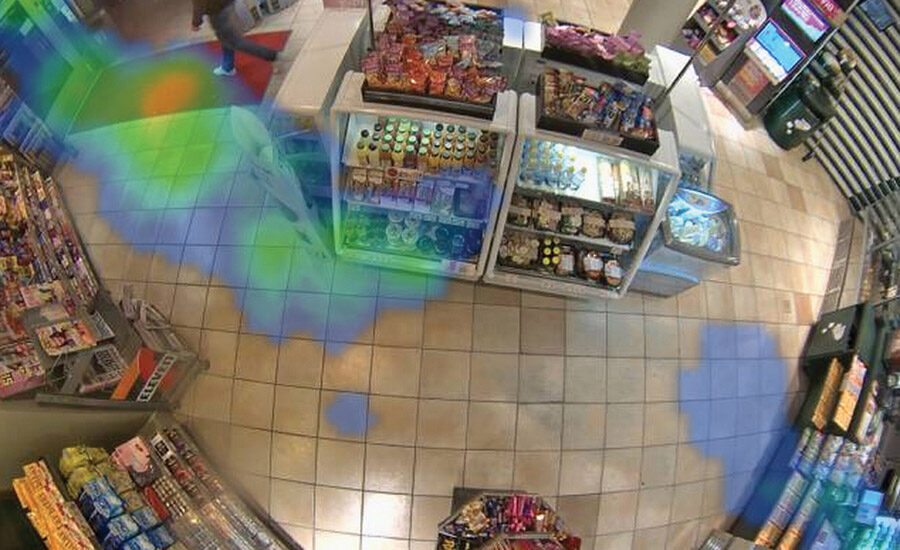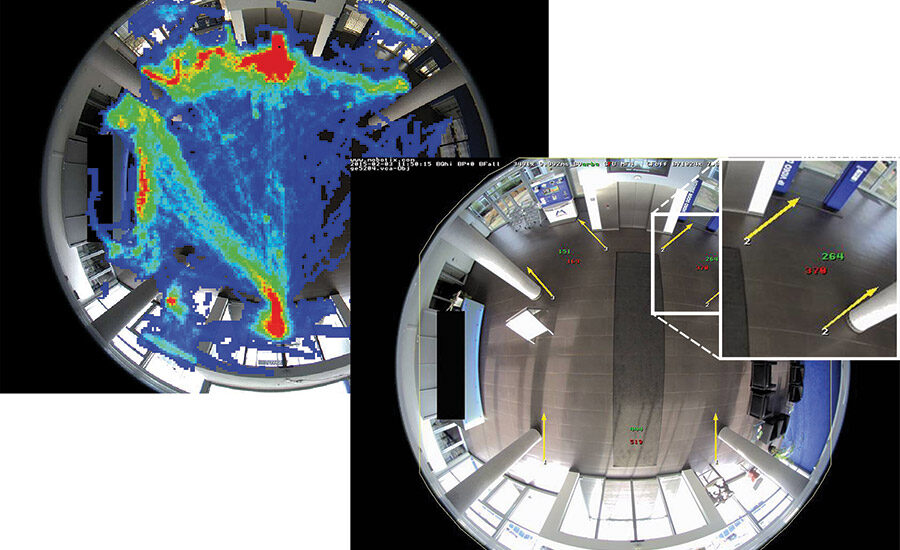Finding & Selling The Value of Analytics

Heat-mapping analytics can help retailers determine which areas of a store generate the most foot traffic and where customers linger the longest, for example, to make informed choices about merchandising, staffing levels and more.
PHOTO COURTESY OF AXIS COMMUNICATIONS

Video analytics allow end users to track areas where the highest level of activity and movement occurs, which can be used for both security and/or non-security purposes.
PHOTO COURTESY OF MOBOTIX


First things first. There is no doubt that video analytics got off to a rocky start in the security industry. However, from that early “over-promise/under-deliver” phase, video analytics have over the last few years evolved into a powerful and effective security tool.
“Video analytics offer more intelligent responses to the video,” says Michael Hendrix, technical support manager for City of Industry, Calif.-based Hikvision USA. “With video analytics, you are able to limit false alarms and make the video more searchable for events. This helps the end users receive more accurate notifications and find the video they are looking for more quickly.”
Given that today’s analytics are a far cry from their predecessors, much of the stigma associated with those early technologies has gone by the wayside. It has become increasingly clear among those in the industry that there can be great value in video analytics. But what, exactly, is that value?
There are any number of possibilities, but each is rooted in one simple thing: data.
“The value to the end user is the data. Video analytics provide a way to validate and provide more detail to augment staff in physical security applications,” says Rob Muehlbauer, Axis Application Development Partner (ADP) program manager for Axis Communications, Chelmsford, Mass. “Increasingly, analytics can provide a way for end users to use video for more than just security. End users can leverage video analytics in ways that enhance their operations and improve processes — positively impacting the company’s bottom line.”
Security has long been the hallmark of analytics, but today it is often the “beyond security” applications — especially those that can help improve a company’s business operations — that are the real sweet spot for video analytics.
“Systems integrators often think of video analytics in terms of security applications and how they can be used to identify, prevent or investigate crimes,” says Masa Karahashi, senior vice president of engineering for San Francisco-based 3VR. “However, video analytics can be a useful way for end users to extract business intelligence from the surveillance videos they are already collecting.”
The value of the behavioral intelligence that can be gleaned from video analytics is something the retail industry in particular has grasped.
“In the retail market you can follow the behavior patterns of shoppers, such as whether a large number of shoppers frequent a particular isle more than others or stop at a particular display. This puts brick-and-mortar retailers on more of a level playing field with the online retailers, which are able to easily extract data on the behavior of their online shoppers,” says Jammy DeSousa, product manager for the American Dynamics brand of Tyco Security Products, Westford, Mass.
Identifying the best value proposition of video analytics for a customer becomes much more important when you consider that the audience of decision-makers has grown to encompass many more people than just security management.
“End users — especially those within the C-suite — are always looking for ways to utilize existing investments in multiple ways, making video surveillance and analytics an ideal way to gain the most value from investments,” says Jumbi Edulbehram, regional president, Americas, Oncam, Lowell, Mass.
Translating Value Into Sales
Once you know the many ways video analytics can deliver value to end users, it’s important to be able to communicate that value in a way that will lead to sales. But before you launch into a full-fledged pitch, ask yourself, “What does the customer need?” Better yet, ask the customer.
“What are their pain points? The integrator then needs to draw a parallel between those pain points and the issues that can be solved by deploying a video analytics-based solution,” DeSousa says.
Because data is the key value that drives the benefits of video analytics, understanding the implication of the technology on the massive amounts of data that are generated by security and non-security systems today will help integrators speak the language of business managers and executives.
“The big data trend is a relatively new one, so many business leaders do not yet fully understand how to use analytics to mine video data, correlate it with other contextual data, and then use that information to improve customers’ experiences and directly help boost their bottom line. But once they are presented with the possibilities, the value of using video analytics in applications beyond security becomes more clear,” Karahashi says.
The greatest advice for selling analytics may be to steer clear of the “sins” of the past.
“Most importantly, integrators must set proper expectations for end users. The customer should understand how the environment can and will affect results,” Muehlbauer says. “By setting the proper expectation up front with the customer, you prove that you are a trusted source and not just trying to sell them a dream.”
And with the right supporting technology in place, analytics can generate that all-important RMR integrators are looking for.
“A properly designed video security system, in conjunction with a UL-listed smart monitoring center, translates into great ROI for end customers and a solid source of recurring revenue for systems integrators,” says Keith Jernigan Sr., general manager for New York-based Mobotix.
What’s Next?
As technology and the industry as a whole continue to evolve, it’s natural to wonder what might be the next big thing in a particular segment. For analytics, one of those coming attractions that will enable more creative applications is a term that has been increasingly discussed in security of late.
“For outside-the-box, the next opportunity for video analytics is the Internet of Things (IoT), where there is more of a focus on business intelligence and providing meaningful data and statistics,” DeSousa says. (For more on IoT, see this month’s cover story beginning on page 54.)
Another major boon to video analytics that should continue is the ability for manufacturers to integrate their analytics with third-party developers’ technology to address specific end-user needs with a wide range of applications, all made possible by open-standard, IP-based technology. Axis is one of a number of manufacturers that allow these applications to be downloaded and installed on their network cameras and other surveillance equipment through its ACAP program. These third-party apps can extend the core functionality of a camera, Muehlbauer says.
“It’s exciting to see applications where analytics are used with video in non-physical security applications. With these types of applications, you can show a customer how to improve their operations and processes and realize an actual short-term ROI that they can show management and justify the cost for the solution’s implementation,” he says.
One of the most elegant aspects of video analytics is the way that the same algorithms that are used to perform security-related functions can serve a dual purpose by simultaneously performing non-security applications. As awareness of the ability for analytics to provide business advantages increases, this factor should take center stage, Karahashi says.
“There are many types of video analytics that can be used for both security and business intelligence. For instance, facial recognition is useful for identifying a fraudster during an investigation,” he says. “However, that same analytic can help high-end retailers or hotels identify the presence of a VIP, helping them provide prompt and personalized attention. People-counting analytics can alert security staff when a restaurant, bar or club reaches capacity. However, people-counting can also help retailers calculate accurate conversion rates, optimize store staffing, or determine how many customers stop at an important display.”
Video analytics are still an emerging technology, which will require some non-traditional thinking and education on the integrator side. But the rewards are well worth it, Karahashi says.
“The applications for video analytics are nearly endless, and with a little creative thinking and problem solving, integrators can help end users buy into uses beyond security, improving both the bottom lines and the consumers’ experience,” he says. “Selling these solutions is a win-win for both end users and integrators. The end users get useful business intelligence, and furthermore, they frequently prefer to pay on a recurring basis, rather than as a one-time capital expense, meaning integrators can capture monthly recurring revenue.”
SIDEBAR: Creative Applications
3VR, Masa Karahashi: “We have seen innovative examples where fitness studios are using people-counting analytics to track class attendance as a measure of instructor performance. Are gym members staying in the class until the end, or are they dropping out partway through because the class is not enjoyable? This information helps businesses better understand their customers’ needs and behaviors so that they can be served better.”
American Dynamics, Jammy DeSousa: “One grocery store customer of ours had a theft issue relating to a specific item, but when they placed that item behind the customer service desk, sales decreased significantly. By deploying video analytics, that retailer could now place that item back on the shelf and have an alert sent when the item left the shelf, enabling a clerk to identify if a theft was in progress.”
Looking for a reprint of this article?
From high-res PDFs to custom plaques, order your copy today!









